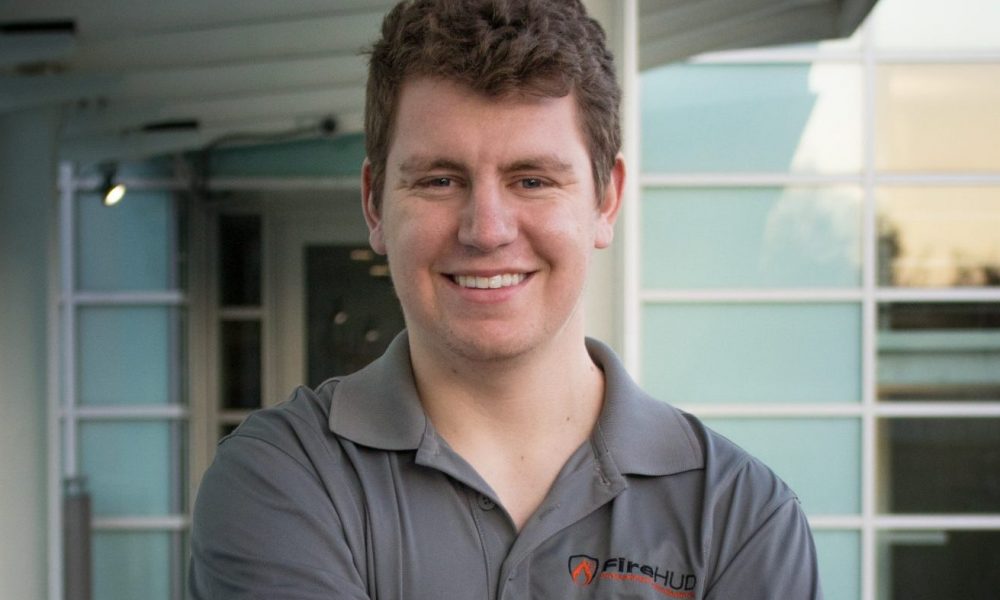

Today we’d like to introduce you to Zack Braun.
Zack, let’s start with your story. We’d love to hear how you got started and how the journey has been so far.
Tyler Sisk (roommate at the time) and I (Zack) started FireHUD while at Georgia Tech. We wanted to help first responders through technology and originally came up with the idea for a heads up display after talking to a family friend at the Atlanta Fire Department (AFD). Hence the name FireHUD – Fire H(Heads), U(Up), D(Display). The AFD and other metro fire departments taught us about firefighting in general as well as the lack of situational awareness that occurs in such a chaotic environment. Imagine being in a building where it’s extremely hot and so smoky and dark that you can’t see more than 5 inches past your face. We then learned about Georgia Tech Create-X’s Idea-to-Prototype class and immediately thought it would be a perfect way to work on this idea while earning class credit. We then won the Georgia Tech InVenture prize in 2016. By our senior year, we recruited our classmate Joe Boettcher to join us. On our last day before graduation, we won a Small Business Innovation Research (SBIR) grant from the National Science Foundation to continue development full-time into 2018.
The grant-funded R&D helped us rapidly prototype our idea. We were able to immediately start building around 30 heads-up display units and put them in the hands of select fire departments to trial. In parallel with these trials, we attended a conference called the National Fallen Firefighter Foundation (NFFF) Physiological Monitoring Technology Summit, which was crucial in pivoting the company towards a product that was more usable and adaptable. What was great for this particular conference was the keynote presentation was a fire chief who talked about his department’s experience with physiological monitoring and the problems current physiological systems encounter. (early competitor of ours) At the conference, we were able to show our heads-up display to fire chiefs from across the nation. Based on their feedback coupled with the pilot sites, we decided to pivot to an armband wearable device. Nine months later, at the end of the NSF Phase I, we had finished development of the first commercially-viable physiological monitoring platform tailored to first responders which we now call the BioTrac Platform. The BioTrac Platform is made up of three parts, the BioTrac Band (the wearable device), the BioTrac Gateway (long-range radio transceiver) and the BioTrac Web Application (real-time software dashboard).
Since then, we have continued to deploy our system to firefighters across the globe. We currently have over 100 devices in the field across +10 deployments on three continents. Most recently, we have been awarded a National Science Foundation (NSF) Phase II SBIR and an Air Force Phase II SBIR contract. Both of these started in Fall 2019 and we are very focused on executing them. In parallel to the NSF and Air Force contracts, we are working with a local contract manufacturer in Georgia to begin scaling the manufacturing for the BioTrac Platform’s hardware. We plan to have a large quantity of devices manufactured this summer and plan to sell to our three target markets that suffer injuries and deaths from heat stress and overexertion: first responders, military, and industrial facilities.
Great, so let’s dig a little deeper into the story – has it been an easy path overall and if not, what were the challenges you’ve had to overcome?
The hardest part of the technology was creating a passive system that provided actionable insights. The entire system needed to not interfere with the end user’s current workflow. This mindset along with continual input from the first responder community, we created our competitive advantage which is the ability to practically and easily monitor the physiology of a large group of people in a rugged, passive means at long distances. For example, the FireHUD Bands require no configuration and will send alerts when necessary — allowing first responders to be notified before injuries occur, but to be able to focus on the task at hand otherwise. Additionally, FireHUD has developed an algorithm for “Exertion” that quantifies the current state of physiological strain for each individual user. This Exertion metric is a 0 to 100% value that allows commanders to easily glean the current workload of each responder in their team — removing the need to know individual heart rate thresholds.
It has been a smooth road, but with some sharp turns thrown in. The team and I have spent most of our time developing the technology, gathering feedback, and — of course — trying to get funding. The funding from the National Science Foundation in 2018 propelled our team to new heights and led us to make great strides based on user feedback. But when the funding dried up at the start of 2019, we were left with a technology that we couldn’t manufacture due to the capital intensity of manufacturing our hardware system. Luckily, Tyler, Joe and I lived off our savings from various internships from college for the next eight months while we watched the FireHUD bank account dwindle. At one point, it even went negative! I didn’t even know that was possible.
I remember having a tough conversation with the rest of the team about what we would do if we weren’t able to secure more funding when the next night Joe called me and said we had just been awarded an Air Force contract to deploy 300 devices to monitor recruits for heat stress. The Air Force contract kicked us into hyperdrive and then we quickly secured another Air Force contract, National Science Foundation R&D funding and were even named to Forbes 30 under 30. Seeing it all snowball has been very surreal. Last month we just secured our third Air Force contract and now have almost $2 million in funding from grants and contracts from the Air Force.
Please tell us about FireHUD.
FireHUD has developed a solution for passive physiological monitoring of individuals and groups called the BioTrac Platform. The solution is currently in use in the fire service, industrial sector, and military.
The system monitors various vital signs such as heart rate, core body temperature, and exertion using a non-invasive armband. The software issues alert for dangerous levels of physiological strain and oxygen saturation. The software allows for real-time group monitoring, but it also provides tools for authorized officials to review and analyze biometrics in order to pinpoint weaknesses in training regimens and assess the health of individuals in their group.
FireHUD’s target end-users work dangerous jobs that would hugely benefit from biometric monitoring, but often these end-users do not have the time to manage a complicated system while they are responding to an emergency or executing their normal workflows. For this reason, passivity is one of the most important features that FireHUD provides. To enable physiological monitoring during demanding mission environments, FireHUD’s platform conceals the complexity from its end-users so they can focus on the mission at hand.
The proudest moment came from a discussion with one of our fire departments that purchased our system. During a training burn, the training captain was alerted of high core body temperature of a firefighter who was inside the burn building and radio’d to another firefighter inside the building to check on him. When the other firefighter made contact with him, it was visually apparent that the firefighter was having trouble based on visual signals. The rest of the firefighters there immediately pulled him from the fire and EMS put an IV in his arm to cool his core body temperature and rehydrate the firefighter. The firefighter quickly recovered and was able to go home to his family that night. When the training captain was retelling this to me afterwards he said without our system that the firefighter would have passed out in the fire because they wouldn’t have been alerted that anything was wrong in the first place. The firefighter would then likely have had to spend a few days in the hospital recovering. This is the proudest moment to me because while unfortunately this event occurred our technology directly helped a firefighter have a better outcome.
Contact Info:
- Address: 1701 Oakbrook Dr., Suite K, Norcross GA 30093
- Website: www.firehud.co
- Phone: 6787495878
- Email: info@firehud.co
- Facebook: https://www.facebook.com/FireHUDinc/
- Twitter: https://twitter.com/FireHUDinc
- Other: https://www.linkedin.com/company/firehudinc/









Suggest a story: VoyageATL is built on recommendations from the community; it’s how we uncover hidden gems, so if you or someone you know deserves recognition please let us know here.



















